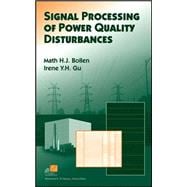
Irene Y.H. Gu grew up in Shanghai, China. She moved to The Netherlands in 1988 and received the PhD degree in 1992. Since 1996 she has been with the Department of Signals and Systems, Chalmers University of Technology (Gothenburg, Sweden) and has been a professor in signal processing there since 2004. She is also a guest professor at Shanghai Jiao Tong University (China). Irene Gu and Math Bollen were married in Eindhoven in 1992.
| PREFACE. | |||
| ACKNOWLEDGMENTS. | |||
| 1 INTRODUCTION. | |||
|
|||
|
|||
|
|||
|
|||
|
|||
|
|||
|
|||
|
|||
|
|||
| 2 ORIGIN OF POWER QUALITY VARIATIONS. | |||
|
|||
|
|||
|
|||
|
|||
|
|||
|
|||
| 3 PROCESSING OF STATIONARY SIGNALS. | |||
|
|||
|
|||
|
|||
|
|||
|
|||
|
|||
|
|||
|
|||
| 4 PROCESSING OF NONSTATIONARY SIGNALS. | |||
|
|||
|
|||
|
|||
|
|||
|
|||
|
|||
|
|||
| 5 STATISTICS OF VARIATIONS. | |||
|
|||
|
|||
|
|||
|
|||
|
|||
|
|||
|
|||
| 6 ORIGIN OF POWER QUALITY EVENTS. | |||
|
|||
|
|||
|
|||
|
|||
| 7 TRIGGERING AND SEGMENTATION. | |||
|
|||
|
|||
|
|||
|
|||
|
|||
| 8 CHARACTERIZATION OF POWER QUALITY EVENTS. | |||
|
|||
|
|||
|
|||
|
|||
|
|||
|
|||
|
|||
|
|||
|
|||
|
|||
|
|||
| 9 EVENT CLASSIFICATION. | |||
|
|||
|
|||
|
|||
|
|||
|
|||
|
|||
|
|||
|
|||
| 10 EVENT STATISTICS. | |||
|
|||
|
|||
|
|||
|
|||
|
|||
| 11 CONCLUSIONS. | |||
|
|||
|
|||
|
|||
|
|||
|
|||
| APPENDIX A IEC STANDARDS ON POWER QUALITY. | |||
| APPENDIX B IEEE STANDARDS ON POWER QUALITY. | |||
| BIBLIOGRAPHY. | |||
| INDEX. |
The New copy of this book will include any supplemental materials advertised. Please check the title of the book to determine if it should include any access cards, study guides, lab manuals, CDs, etc.
The Used, Rental and eBook copies of this book are not guaranteed to include any supplemental materials. Typically, only the book itself is included. This is true even if the title states it includes any access cards, study guides, lab manuals, CDs, etc.